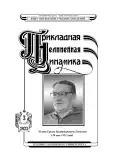Mathematical model of three competing populations and multistability of periodic regimes
- Authors: Nguyen B.H.1, Tsybulin V.G.1
-
Affiliations:
- Southern Federal University
- Issue: Vol 31, No 3 (2023)
- Pages: 316-333
- Section: Articles
- URL: https://journals.rcsi.science/0869-6632/article/view/250958
- DOI: https://doi.org/10.18500/0869-6632-003038
- EDN: https://elibrary.ru/HHZEBK
- ID: 250958
Cite item
Full Text
Abstract
About the authors
Buu Hoang Nguyen
Southern Federal Universityul. Bol`shaya Sadovaya 105/42, Rostov-on-Don, 344006, Russia
Vyacheslav Georgievich Tsybulin
Southern Federal Universityul. Bol`shaya Sadovaya 105/42, Rostov-on-Don, 344006, Russia
References
- Свирежев Ю. М., Логофет Д. О. Устойчивость биологических сообществ. М.: Наука, 1978. 352 с.
- Мюррей Дж. Математическая биология. Т. 1. Введение. М.–Ижевск: Институт компьютерных исследований; Регулярная и хаотическая динамика, 2011. 776 с.
- Базыкин А. Д. Нелинейная динамика взаимодействующих популяций. Ижевск: Институт компьютерных исследований, 2003. 368 c.
- Rubin A., Riznichenko G. Mathematical Biophysics. New York: Springer, 2014. 273 p. DOI: 10. 1007/978-1-4614-8702-9.
- Фрисман Е. Я., Кулаков М. П., Ревуцкая О. Л., Жданова О. Л., Неверова Г. П. Основные направления и обзор современного состояния исследований динамики структурированных и взаимодействующих популяций // Компьютерные исследования и моделирование. 2019. Т. 11, № 1. С. 119–151. doi: 10.20537/2076-7633-2019-11-1-119-151.
- Lotka A. J. Elements of Physical Biology. Philadelphia, Pennsylvania: Williams & Wilkins, 1925. 495 p.
- Volterra V. Variazioni e fluttuazioni del numero d’individui in specie animali conviventi // Memoria della Reale Accademia Nazionale dei Lincei. 1926. Vol. 2. P. 31–113.
- May R. M., Leonard W. J. Nonlinear aspects of competition between three species // SIAM Journal on Applied Mathematics. 1975. Vol. 29, no. 2. P. 243–253. doi: 10.1137/0129022.
- Chia-Wei C., Lih-Ing W., Sze-Bi H. On the asymmetric May–Leonard model of three competing species // SIAM Journal on Applied Mathematics. 1998. Vol. 58, no. 1. P. 211–226. DOI: 10.1137/ S0036139994272060.
- Antonov V., Dolicanin D., Romanovski V. G., Toth J. Invariant planes and periodic oscillations in the May–Leonard asymmetric model // MATCH Communications in Mathematical and in Computer Chemistry. 2016. Vol. 76, no. 2. P. 455–474.
- van der Hoff Q., Greeff J. C., Fay T. H. Defining a stability boundary for three species competition models // Ecological Modelling. 2009. Vol. 220, no. 20. P. 2640–2645. doi: 10.1016/j.ecolmodel. 2009.07.027.
- Hou Z., Baigent S. Heteroclinic limit cycles in competitive Kolmogorov systems // Discrete & Continuous Dynamical Systems. 2013. Vol. 33, no. 9. P. 4071–4093. doi: 10.3934/dcds.2013. 33.4071.
- Zeeman E. C., Zeeman M. L. An n-dimensional competitive Lotka–Volterra system is generically determined by the edges of its carrying simplex // Nonlinearity. 2002. Vol. 15, no. 6. P. 2019–2032. doi: 10.1088/0951-7715/15/6/312.
- Zeeman E. C., Zeeman M. L. From local to global behavior in competitive Lotka-Volterra systems // Transactions of the American Mathematical Society. 2003. Vol. 355, no. 2. P. 713–734. doi: 10.1090/s0002-9947-02-03103-3.
- Chen X., Jiang J., Niu L. On Lotka–Volterra equations with identical minimal intrinsic growth rate // SIAM Journal on Applied Dynamical Systems. 2015. Vol. 14, no. 3. P. 1558–1599. doi: 10.1137/15M1006878.
- Jiang J., Liang F. Global dynamics of 3D competitive Lotka-Volterra equations with the identical intrinsic growth rate // Journal of Differential Equations. 2020. Vol. 268, no. 6. P. 2551–2586. doi: 10.1016/j.jde.2019.09.039.
- Нгуен Б. Х., Ха Д. Т., Цибулин В. Г. Мультистабильность для системы трех конкурирующих видов // Компьютерные исследования и моделирование. 2022. Т. 14, № 6. С. 1325–1342. doi: 10.20537/2076-7633-2022-14-6-1325-1342.
- Юдович В. И. О бифуркациях при возмущениях, нарушающих косимметрию // Доклады Академии наук. 2004. Т. 398, № 1. С. 57–61.
- Yudovich V. I. Secondary cycle of equilibria in a system with cosymmetry, its creation by bifurcation and impossibility of symmetric treatment of it // Chaos. 1995. Vol. 5, no 2. P. 402–411. doi: 10.1063/1.166110.
- Епифанов А. В., Цибулин В. Г. Моделирование колебательных сценариев сосуществования конкурирующих популяций // Биофизика. 2016. Т. 61, № 4. С. 823–832.
- Епифанов А. В., Цибулин В. Г. О динамике косимметричных систем хищников и жертв // Компьютерные исследования и моделирование. 2017. Т. 9, № 5. С. 799–813. doi: 10.20537/2076- 7633-2017-9-5-799-813.
- Ха Д. Т., Цибулин В. Г. Мультистабильные сценарии для дифференциальных уравнений, описывающих динамику системы хищников и жертв // Компьютерные исследования и моделирование. 2020. Т. 12, № 6. С. 1451–1466. doi: 10.20537/2076-7633-2020-12-6-1451- 1466.
- Fay T. H., Greeff J. C. A three species competition model as a decision support tool // Ecological Modelling. 2008. Vol. 211, no. 1–2. P. 142–152. doi: 10.1016/j.ecolmodel.2007.08.023.
- Башкирцева И. А., Карпенко Л. В., Ряшко Л. Б. Стохастическая чувствительность предельных циклов модели «хищник – две жертвы» // Известия вузов. ПНД. 2010. Т. 18, № 6. С. 42–64. doi: 10.18500/0869-6632-2010-18-6-42-64.
- Абрамова Е. П., Рязанова Т. В. Динамические режимы стохастической модели «хищник– жертва» с учетом конкуренции и насыщения // Компьютерные исследования и моделирование. 2019. T. 11, № 3. С. 515–531. doi: 10.20537/2076-7633-2019-11-3-515-531.
- Bayliss A., Nepomnyashchy A. A., Volpert V. A. Mathematical modeling of cyclic population dynamics // Physica D: Nonlinear Phenomena. 2019. Vol. 394. P. 56–78. doi: 10.1016/j.physd. 2019.01.010.
- Frischmuth K., Budyansky A. V., Tsybulin V. G. Modeling of invasion on a heterogeneous habitat: taxis and multistability // Applied Mathematics and Computation. 2021. Vol. 410. P. 126456. doi: 10.1016/j.amc.2021.126456.
- Будянский А. В., Цибулин В. Г. Моделирование динамики популяций на неоднородном ареале: инвазия и мультистабильность // Биофизика. 2022. Т. 67, № 1. С. 174–182. DOI: 10.31857/ S0006302922010197.
- Ха Т. Д., Цибулин В. Г. Мультистабильность для математической модели динамики хищников и жертв на неоднородном ареале // Современная математика. Фундаментальные направления. 2022. Т. 68, № 3. С. 509–521. doi: 10.22363/2413-3639-2022-68-3-509-521.
- Понтрягин Л. С. Обыкновенные дифференциальные уравнения. Ижевск: Регулярная и хаотическая динамика, 2001. 400 с.
- Waugh I., Illingworth S., Juniper M. Matrix-free continuation of limit cycles for bifurcation analysis of large thermoacoustic systems // Journal of Computational Physics. 2013. Vol. 240. P. 225–247. doi: 10.1016/j.jcp.2012.12.034.
Supplementary files










